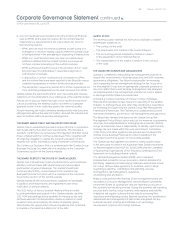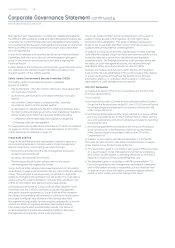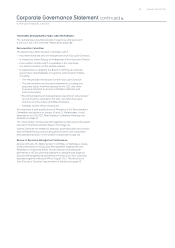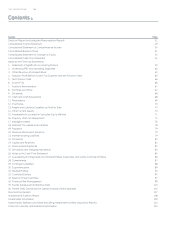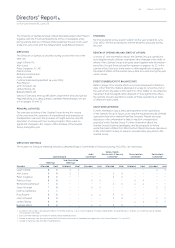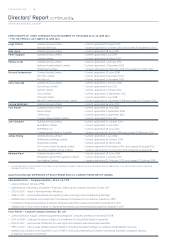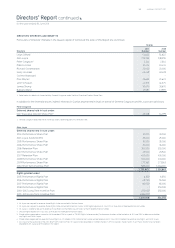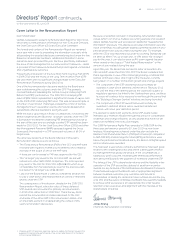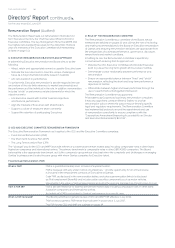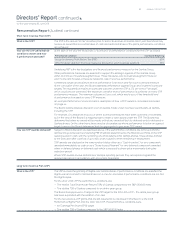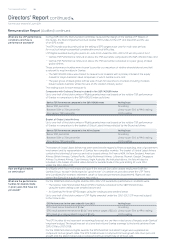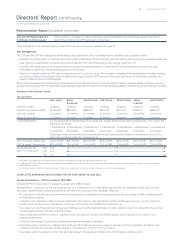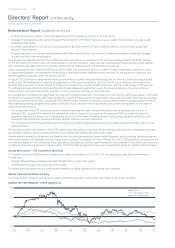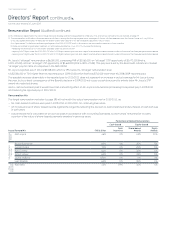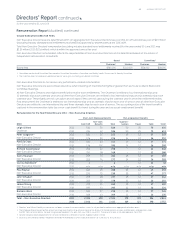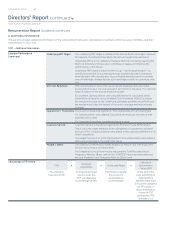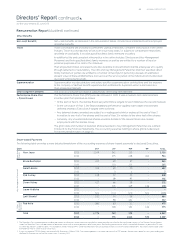Qantas 2011 Annual Report Download - page 37
Download and view the complete annual report
Please find page 37 of the 2011 Qantas annual report below. You can navigate through the pages in the report by either clicking on the pages listed below, or by using the keyword search tool below to find specific information within the annual report.
35 ANNUAL REPORT 2011
for the year ended 30 June 2011
Directors’ Report continued
Dear Shareholder
Qantas is pleased to present its Remuneration Report for /,
which sets out remuneration information for Non-Executive Directors,
the Chief Executive Ofcer (CEO) and Executive Committee.
The format and content of the Remuneration Report are reviewed
each year with a view to presenting the information concisely, while
still providing the detailed disclosure elements required under the law.
Based on shareholder feedback, additional information in some
areas has been provided this year. We have specically addressed
the issue of risk management in our remuneration framework – detail
is provided of the framework features that protect against unintended
and unjustied pay outcomes.
Following the introduction of the new Short Term Incentive Plan (STIP)
in / and the review of the Long Term Incentive Plan (LTIP)
last year, there were no signicant changes made to the Executive
Remuneration Framework during /.
One of the key remuneration decisions made by the Board each
year is determining the outcome under the STIP. This primarily
involves the Board assessing the Qantas Group’s Underlying Prot
Before Tax (PBT) performance. The / Underlying PBT
result of $ million represented a signicant increase of per cent
on the / Underlying PBT result. This was achieved in spite of
a number of well-known challenges outside the control of Qantas
management such as weather events and natural disasters that
substantially affected operations during the year.
While this was a good result in those circumstances, it was below the
stretch target set by the Board for “at target” awards under the STIP.
It did however exceed the Underlying PBT threshold that was set at
the start of the year and accordingly a partial STIP award has been
made for /. For the Chief Executive Ofcer (CEO) (and other
Key Management Personnel (KMP) assessed against the Group
Scorecard), this resulted in a STIP scorecard outcome of .% of
target levels.
The other key decisions of the Board reected in this year’s
Remuneration disclosures are as follows:
— The Fixed Annual Remuneration (FAR) of the CEO and KMP were
reviewed with regard to market pay movements and a material
increase in the scope of one of the KMP roles
A three per cent increase to FAR was approved for the CEO
— The “at target” pay levels for the CEO and KMP are set with
reference to other S&P/ASX companies. The total reported
pay level for the CEO for / is $,,, which is up
considerably from his reported pay level for the previous year,
but below his “at target” pay of $,,
— Last year the Board made a carefully considered decision not
to pay a cash bonus and instead make an award of restricted
shares under the STIP
The consequence of this decision, detailed in the /
Remuneration Report, is that the value of these deferred
STIP awards are accounted for primarily as remuneration
in / rather than in /. This is the key factor
behind the remuneration increases disclosed for the CEO
and some of the other KMP in the remuneration tables, and
an important element in understanding the context of this
year’s remuneration disclosures.
Because of potential confusion in interpreting remuneration table
values (which can involve multiple accounting periods and valuation
dates) Qantas has this year provided an additional “Supplemental
Information” disclosure. This disclosure provides information as to the
value of earnings, including share-based payments reported in prior
periods which have actually vested during the year. For example,
while the CEO’s total reported pay (under Accounting Standards) can
be seen as either % up on last year, or % below his “at target”
pay for the year, it can also be seen as % down against last year
when viewed on the basis of “Total Vested Remuneration”, or the
amount of pay realised during the year.
Again this year, the Board has decided to defer all awards to the
CEO and KMP under the / STIP. The Board considers that
this is appropriate in view of the challenging trading conditions that
Qantas continues to face, and in light of the measures currently
being taken on a number of important growth and change projects.
— The component of the STIP award that would normally be
awarded in cash will be deferred until the end of February .
Up until the end of the deferral period, the award will, subject to
regulatory approval, be linked to the Qantas share price, and thus
its value will continue to be exposed to risk through the period that
the “Building a Stronger Qantas” initiatives are being launched
— The component of the STIP award that would normally be
awarded in deferred shares, will be awarded as deferred
shares, with a two year restriction period
This decision to defer both elements of the STIP Award is also
intended as a retention initiative through this period of considerable
challenge and change initiatives, as any awards that have not yet
vested are forfeited if the executive resigns.
The Performance Rights Plan, awarded in / for the
three year performance period to June has now been
nalised. Nil vesting was achieved under this plan as both the
Relative Total Shareholder Return (TSR) performance (in comparison
to S&P/ASX) and Earnings Per Share (EPS) performance were
below the performance thresholds set by the Board. All Rights lapsed
and no shares were awarded.
This has been a year where company performance has been good
relative to the challenges faced, and where a strong performance
by management has produced what is, in the circumstances, a
satisfactory prot outcome, exceeding the threshold performance
level set by the Board for the payment of incentives under the STIP.
The linking of the LTIP to shareholder returns and the exibility in the
operation of the STIP around the deferral of short term incentive
awards are key features of the Qantas Executive Reward framework.
These features support the Board’s aim of appropriate alignment
between business outcomes, pay outcomes and returns to
shareholders. In taking the decisions I have outlined around the pay
of its CEO and Executive Committee, the Board has used this exibility
to achieve what we believe is an appropriate mix of fair reward,
retention of key executives and alignment with the interests of the
shareholders of Qantas.
James Strong
Chairman, Remuneration Committee
Cover Letter to the Remuneration Report
. Underlying PBT is the primary reporting measure used by the Qantas Group for the
purpose of assessing the performance of the Group. Refer Note (D) of the Notes
to the Financial Statements.


